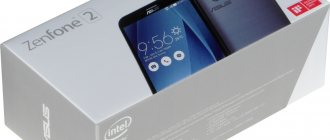Technologies ASUS ZenFone 5Z
The most powerful Qualcomm Snapdragon 845 processor
Inside the ASUS Zenfone 5Z is the fastest processor available in a smartphone. This is a Qualcomm Snapdragon 845 with four Kryo 385 Gold and four Kryo 385 Silver cores, as well as a powerful Qualcomm Adreno 630 accelerator. For such hardware, there are no impossible tasks or mobile games in which you will need to set settings below the maximum.
Smart camera
ASUS ZenFone 5Z is equipped with a smart camera that can independently recognize shooting conditions using artificial intelligence technologies. Also, thanks to such “smart” support from the processor, the camera will study the parameters at which the user takes photographs, and then independently turn them on, depending on the type of shooting.
Smart battery and fast charging
ASUS ZenFone 5Z supports Quick Charge fast charging mode, so it takes about an hour to fully charge the smartphone's battery. However, most often the smartphone is left to charge overnight, in which case it remains connected to the charger for a long time. Fast charging is not required in this mode of use. Rather, it will be harmful to the battery. Therefore, ASUS ZenFone 5Z has support for “smart charging”. In this case, the smartphone will understand that it has, for example, 7 hours to charge and will begin to stretch the battery charging time, adjusting to this time.
Smart charging works in two modes. In automatic mode, the smartphone will adjust to the time of “night” charging, and in manual mode, the user can set a schedule for turning smart charging on and off.
Live emotions ZENIMOJI
ZENIMOJI technology is useful for video broadcasts and video calls. With its help, you can replace the user's face with an animated emoticon. The latter will repeat the user's eye movements and facial expressions.
Sound
As in the case of the younger model, the tested gadget uses an earpiece as an additional one, which made it possible to reproduce stereo sound. In fact, the stereo effect is really felt, but the speakers are unequal and have completely different frequency responses. The earpiece speaker is focused on reproducing high frequencies, and the main system speaker takes care of providing a sufficient volume level and adding volume (bass) to the sound. As for the overall sound quality, it is pleasantly surprising. Surprisingly, the sound seemed even more interesting than in ASUS ZenFone 5, although in theory the same speakers should be used. From the subjective point of view of the test subject, it is quite possible to put them on a par with the Samsung Galaxy S9/S9+. But the hero of the material still falls a little short of the Sony Xperia XZ1/XZ2 families, because these mobile gadgets use a pair of equivalent large speakers (which in turn affects the dimensions).
See also: Xiaomi Mi Pad 4: the world's first tablet with Snapdragon 660
When playing a test sinusoidal signal with a frequency of 1 kHz at a distance of 1 meter from the device, a level of 77.3 dBA was recorded, which is only slightly more than in the case of ASUS ZenFone 5.
But on the analog audio output the signal level turned out to be significantly lower than that of the younger model. When playing the test signal and operating with a 32 Ohm load, a level of 205.7 mV was recorded, and when using a 16 Ohm load – 172.8 mV. When listening to music, for example, in a noisy subway, this level may simply not be enough even when using headphones with high sensitivity. Perhaps new firmware in the future will correct the situation with the power on the audio output.
The sound quality on the analog audio output was assessed in the special RightMark Audio Analyzer application using the Creative E-MU 0204 USB audio interface. The overall result was "very good". The gadget could have earned the highest score here, if not for the frequency response. Judging by the nature of the resulting frequency response, this is an obvious problem with the raw firmware, so boxed samples most likely will not have this problem, and the device will easily earn an “excellent” rating.
General results 24 bit/48 kHz
| Frequency response unevenness (in the range 40 Hz - 15 kHz), dB | -1.10, -2.40 | Average |
| Noise level, dB (A) | -97.2 | Great |
| Dynamic range, dB (A) | 95.5 | Great |
| Harmonic distortion, % | 0.00338 | Very good |
| Harmonic distortion + noise, dB(A) | -81.4 | Fine |
| Intermodulation distortion + noise, % | 0.011 | Very good |
| Interpenetration of channels, dB | -92.5 | Great |
| Intermodulation at 10 kHz, % | 0.00627 | Great |
| Overall rating | Very good |
Description ASUS ZenFone 5Z
The smartphone comes in a compact blue box. The regular ZenFone 5 has exactly the same packaging. Only the name of the 5Z smartphone is in “golden” font. Still, this is a flagship and even its box must correspond to its status.
In addition to the ASUS ZenFone 5Z (ZS620KL), power supply, “clip” and standard instructions, the kit included a headset and a silicone case. Additional accessories included in the kit are always nice, and even necessary for flagship solutions.
ZenFone 5Z looks exactly the same as the regular ASUS Zenfone 5 (ZE620KL). Externally, the smartphones are identical; they differ from each other in their filling. The simple “five” has a mid-range Qualcomm Snapdragon 636 instead of a flagship processor.
The ASUS ZenFone 5Z has a large screen, 6.2 inches, and it is installed in a case that (in terms of its dimensions) is designed for a 5.5-inch smartphone. In order for the large display to fit into the modest body, it was necessary to “pull” it up: change the aspect ratio and increase the resolution to 2246x1080 pixels. The screen also received a cutout in its upper part - it accommodates the speaker, camera and necessary sensors.
Since the smartphone screen occupies 90% of the area of its front panel, the fingerprint scanner moved to the back of the phone, and the main Android keys were located on the screen. Therefore, there is not even a manufacturer’s logo on the front side of the smartphone. By the way, the front panel is covered with Gorilla Glass.
On the top panel there is a second microphone, which is useful for the noise reduction function during conversations. And at the bottom there is a speaker, a main microphone, a Type-C connector and a 3.5 mm audio jack for a headset. It’s very nice that ASUS did not follow modern fashion to the bitter end and did not remove the audio jack. Therefore, there will be no problems finding headphones for ASUS ZenFone 5Z.
On the right side of the smartphone there are standard volume and “Power” keys, and on the left there is a tray for two SIM cards and a memory card. Installing two SIM cards and a memory card at the same time will not work; the user will have to decide what to sacrifice. However, given the minimum amount of permanent memory of 64 GB, you won’t have to sacrifice anything.
The back side of the smartphone deserves as much attention as its front panel. It's all about the ASUS Zen circles that radiate from the fingerprint scanner. They look impressive because there is a layer of varnish between the protective glass and the circles. Therefore, the back side of ASUS ZenFone 5Z will look beautiful in the sun or in the falling light.
As for the technical equipment, on the back of the ASUS ZenFone 5Z there is the fingerprint scanner already mentioned above (up to 5 “fingers”, unlocking time 0.2 seconds), as well as two cameras with an LED flash and a separate color correction sensor. The first camera (with a regular lens) is suitable for simple shots, and the second camera (with a wide-format lens) is useful for creating beautiful panoramas without stitching.
Review of ASUS ZenFone 5Z ZS620KL smartphone: flagship with Snapdragon 845 and NFC
Table of contents
- Introduction
- Specifications
- Packaging and equipment
- Appearance and design
- Display
- Software and firmware
- Hardware platform and performance
- Safety
- Multimedia
- Wireless Interfaces and Communications
- File system
- Battery life
- Camera
- Comparison with competitors
- Conclusion
Introduction
]ASUS[/anchor] is well known in the digital technology market. This is a popular manufacturer of laptops and PC components, as well as mobile devices, including smartphones.
Not long ago, we told readers about several models of the new line - ASUS Zenfone Max M1, ASUS Zenfone 5 Lite and ASUS ZenFone 5. Their common features were stylish and high-quality cases, a convenient ZenUI software shell and an interesting price by the standards of certified smartphones.
Following them, the flagship of the ZenFone line received our attention. ASUS ZenFone 5Z ZS620KL is built on the top Qualcomm hardware platform and has good characteristics. We will look into the strengths and weaknesses of the new ASUS smartphone.
Let's start, as always, with the technical characteristics of the new product.
announcements and advertising
2080 Super Gigabyte Gaming OC for 60 rubles.
Compeo.ru - the right comp store without any tricks
RTX 2060 becomes cheaper before the arrival of 3xxx
Ryzen 4000
series included in computers already in Citylink
The price of MSI RTX 2070 has collapsed after the announcement of RTX 3xxx
Core i9 10 series is half the price of the same 9 series
The price of memory has been halved in Regard - it’s more expensive everywhere
ASUS ZenFone 5Z ZS620KL review: technical specifications
| Device type | Smartphone |
| Model | ASUS ZenFone 5Z ZS620KL |
| CPU | Qualcomm Snapdragon 845 |
| Video processor | Adreno 630 |
| operating system | Android 8.1 |
| Memory, GB | 8 RAM; 256 ROM |
| Screen | 6.2″ IPS, 2246 x 1080 |
| Cameras, Mpix | 12.0+8.0 + 8.0 |
| Net | GSM;WCDMA;LTE |
| Number of SIM cards, pcs. | 2, Nano-SIM |
| MicroSD support | Yes |
| Wireless interfaces | Wi-Fi; Bluetooth; NFC |
| GPS/aGPS/GLONASS | Yes Yes Yes |
| Battery, mAh | 3 300 |
| Dimensions, mm | 153.0 x 75.7 x 7.7 |
| Weight, g | 165 |
| price, rub. | 42 990* |
*Price recommended by the manufacturer.
As you would expect, the flagship model is built on a corresponding SoC and is equipped with large amounts of RAM and main memory. At first glance, the characteristics look balanced, and only tests will show the rest.
Review of ASUS ZenFone 5Z ZS620KL: packaging and accessories
The device is supplied in a dark blue box made of thick cardboard. Structurally, it consists of a lid and a main box, the design style is minimalistic.
On the front side there is the logo of the ZenFone model range and the version name. The back side is occupied by identification information.
Inside we find an envelope with documentation and a protective case. Below is the device itself. It is fixed in a special stand and protected with transport films.
The delivery set includes a wired stereo headset. The accessories are made of high quality, from pleasant materials.
A transparent silicone case is included in the package. It is thin and practically does not increase the dimensions of the case.
The thickness of the case is just enough to compensate for the protrusion of the main camera. Additionally, the camera is protected by a small protrusion around the perimeter of the hole in the case.
The package includes:
- Power adapter;
- USB Type C cable;
- Wired stereo headset;
- Transparent silicone bumper case;
- A key-clip for removing the SIM card slot;
- Documentation.
The packaging is stylish and high quality, the lid fits tightly into place. There is no concern for the safety of the contents. Note that there were no factory seals on the box, but this may be due to our sample being a test device.
Review of ASUS ZenFone 5Z ZS620KL: appearance and design
ASUS ZenFone 5Z is made of glass and metal. The case is carefully assembled, there are no even minimal gaps or backlashes. It resists bending or twisting loads well.
The display occupies almost the entire front panel, and to reduce the upper frame, the manufacturer used a protrusion in the center - the “unibrow” so hated by many. It houses the front camera lens, earpiece and light/proximity sensors.
The bottom frame is slightly wider than the others, but it is devoid of structural elements. The corners of the display are rounded and match the overall style of the case.
The ends are combined into a single metal frame with a matte finish. A smooth transition to the glass surfaces is made by chamfering the frame and rounding the glass itself around the perimeter. As a result, the body is perceived as a single whole.
At the top end there are only plastic jumpers for antennas; there are more elements at the bottom. Here we find AUX and USB Type C ports, as well as the main speaker and microphone.
The configuration of the side faces is standard. On the right are mechanical power and volume control keys, on the left is a slot for two nano-SIMs. Nearby you can see the hole for the microphone of the noise reduction system.
The back side is made of glass. The lid is flat, with roundings around the perimeter. Oleophobic coating allows the cover to remain clean even when used without a cover.
In the upper left corner there is a dual main camera module and an LED flash. Closer to the center we find a fingerprint scanner and the manufacturer’s logo.
The ASUS flagship received a high-quality and stylish case, each element of which is firmly fixed in its place. I was pleased with the presence of an oleophobic coating on the back cover.
ASUS ZenFone 5Z ZS620KL review: display test
In an effort to achieve minimal side bezels, the manufacturer installed a display with an aspect ratio of 19:9. Its diagonal is 6.2 inches, resolution is 2246 x 1080 pixels, pixel density is ~402 ppi. Matrix type – IPS.
Multi-touch technology supports up to ten simultaneous touches.
White appears naturally, although there is a slight gray tint visible.
Black color is characterized by a slight pink tint, which appears when viewed from an angle.
We measured the backlight brightness in various modes and tested the quality of the factory color calibration.
| Brightness level, % | White brightness, cd/m2 | Black brightness, cd/m2 | Contrast, x:1 |
| 100 | 543 | 0.277 | 1960 |
| 75 | 415 | 0.229 | 1812 |
| 50 | 283 | 0.154 | 1838 |
| 25 | 146 | 0.079 | 1848 |
| 0 | 5 | 0 | ∞ |
The backlight brightness range is wide. Moreover, it provides both a good margin for the maximum brightness level and the minimum. Together with the use of high-quality light filters, this ensures good readability of the display in any conditions.
The graphs practically coincided with each other, located on the same line. However, the deviation from the reference value is serious.
The color lines turned out to be close to each other, although their stability cannot be called ideal.
The color temperature is not too high, but the stability of the indicators raises serious questions.
Although the display is based on an IPS matrix, the color range is similar to SuperAMOLED matrices of previous years. There is a serious bias towards green shades.
The points of the gray wedge are grouped on the border of the delta; spurious shades will not bother the user.
If necessary, some display parameters can be adjusted in the settings. There is a Splendid section for this.
The screen turned out to be good, but by no means perfect. It can't be praised for its black accuracy, and the overall level of color calibration could have been better. However, this does not affect the user experience.
ASUS ZenFone 5Z ZS620KL review: software and firmware
All ASUS smartphones run the Android operating system, which uses the proprietary ZenUI shell instead of the standard interface.
The manufacturer regularly supports its products by releasing software updates.
The shell interface is preserved regardless of the model. Not long ago we already reviewed the ASUS ZenFone Max M1, and there are virtually no differences.
I liked the manufacturer's decision to use a protrusion at the top of the display. Along the edges of the protrusion are notification icons from various applications. If they do not fit, when you click in the area of these icons, a second line with a full set of notifications will appear.
The settings menu has not changed. The list of sections is logical, and with the help of comments you can find the desired item even faster.
There are a number of points for customizing a smartphone for a specific user. For example, you can adjust the vibration intensity for different types of notifications or select a design theme.
A whole list of tools is also available that expand the functionality of the smartphone and simplify its use.
One of the useful features is Twin Apps for registering multiple accounts in one application. This function will be relevant, for example, for those who use personal and work accounts on social networks.
In the ZenUI Security section, you can set up an emergency call/send SMS with location information.
Or enable location tracking for selected contacts.
A special mode is provided to protect the battery from premature wear. It allows you to automatically adjust the charging speed depending on your usage style. There are also modes for controlling the user's gaze to keep the display active and automatically adjusting the volume depending on the noise level around.
The fingerprint scanner can be used to quickly view notifications - a very convenient and practical feature
To monitor the status of the smartphone, manage the battery and automatically clear the memory, the Mobile Manager application is provided.
The ZenUI shell is convenient and understandable, it shows good stability and smooth operation. The manufacturer has worked hard to achieve this result. However, some settings items do not have Russification. This does not cause serious difficulties, but from a flagship and certified smartphone you expect complete Russification without any reservations.
Specifications
- Display
- CPU
- Graphic arts
- RAM
- Storage capacity
- Rear cameras
- Front-camera
- Video recording
- Cellular networks:
- Wi-Fi and Bluetooth
- Tray for SIM cards and memory cards
- Connectors
- Navigation
- NFC
- Fingerprint's scanner
- Light sensor
- Proximity sensor
- Gyroscope
- Battery
- operating system
- Approximate price
ASUS ZenFone 5Z
Inside the ASUS ZenFone 5Z is installed the fastest (at the time of this writing) mobile processor Qualcomm Snapdragon 845, announced in December 2020. This CPU has 8 fast cores based on the ARM Cortex-A75 architecture. The first four “fast” cores, Kryo 385 Gold, operate at a frequency of up to 2.8 GHz and are designed to perform complex tasks, such as mobile games or heavy work in mobile Photoshop. The second quad core, Kryo 385 Silver, is useful for everyday use of the smartphone and for light tasks, such as checking mail and instant messengers. The new Snapdragon 845 processor is 25% to 30% faster than its predecessor, the Snapdragon 835, when comparing the two CPUs in terms of high-performance cores. The Adreno 630 accelerator is responsible for graphics processing and at the time of writing this article it is the fastest mobile GPU from Qualcomm.
The amount of RAM and permanent memory will depend on the modification of the smartphone. In Russia, 6/64 GB and 8/256 GB options will be officially available, which differ in the amount of RAM and permanent memory, respectively.
Cameras
In this regard, Zenfone 5Z is doing well. The 12MP main rear camera uses a Sony IMX363 sensor with a 1.4μm pixel size, f/1.8 aperture, Tri Tech autofocus with 0.03 second response time, Dual Pixel phase detection autofocus, 4-axis optical stabilization and electronic image stabilization. The second camera on the back is 8 megapixels with an f/2.0 aperture and an OV8856 sensor, as well as lenses with a viewing angle of 120 degrees. Asus promises a lot of features with artificial intelligence and scene recognition working.
Despite the non-ideal shooting conditions in the light, the device performed quite well. The columns are well lit and there is little digital noise.
Switching to wide-angle makes photos noticeably darker. With 120 degree lenses the distortion becomes quite obvious. There is noticeable noise reduction in the background, which results in loss of detail.
If you zoom in on the image, detail remains at a good level. Highlights appear burnt out in the top left corner, HDR needs further optimization.
Despite the presence of optical stabilization, pictures are blurry and require a steady hand. The 8MP front camera isn't particularly impressive, failing to produce clear images. In low light, results are mixed. There is little noise in the photo, but detail is degraded due to heavy noise reduction processing.
In general, we can say that we liked the cameras. Despite this, the performance is less stable than the OnePlus 6. The wide-angle camera seems interesting on paper, but real-world results are less than satisfactory.
Display and camera ASUS Zenfone 5Z
The flagship's screen should be perfect. There should be no complaints about it either in terms of brightness or color rendition. This is exactly what happened with ASUS Zenfone 5Z. This smartphone has a bright and juicy screen. And in the settings you can turn the blue filter and its auto-on according to a schedule, change the color mode (make the colors colder or warmer), and also adjust the color gamma of the screen. You can use the standard sRGB palette or an extended color range. Including manually configured.
As for the “bangs” near the screen, in real life they don’t cause any discomfort. Applications running in full-screen mode also had no glitches when the “bangs” ate away part of the picture. By the way, in the smartphone settings there is a separate item that will allow you to configure the full-screen mode for each application.
As we already wrote, ASUS Zenfone 5Z received two cameras. The main one, for everyday photos, and the additional one, wide-format. Moreover, these two cameras have “intelligent” support. Thanks to the “artificial intelligence” module, the cameras will independently determine the shooting mode and select the necessary parameters for it. For example, when shooting text, animals or food, the camera will understand what the user wants to shoot and turn on the appropriate settings. The camera will also learn from the user - remember his shooting parameters and turn them on as needed.
The quality of the photos is good. The camera really quickly detects the shooting mode and creates great pictures. We did not notice any problems with the brightness of the frame, and the ASUS Zenfone 5Z also does not have any distorted contrast, due to which colors seem unnaturally bright. In general, the ZenFone 5Z camera is suitable for everyday photos without any problems. It is worth noting that ASUS is constantly improving the smartphone camera. Several firmware versions may be released per month, each of which will improve the functionality of the camera.
By the way, the cameras of Zenfone 5Z and Zenfone 5 are identical, because these smartphones differ only in processors and memory. Therefore, you can get acquainted with the test images in the ASUS ZenFone 5 review.
Software
The software is completely no different from what we have already seen in the ASUS ZenFone 5. It runs Android 8 with the ZenUI 5 shell. There is little additional software. But the functionality of the firmware and its add-ons is pleasantly pleasing. For starters, it's worth noting the facial recognition function, which works quite reliably even in poor lighting, although when setting the function, a message appears indicating that good lighting is required. Also interesting is the Twin Apps feature, which allows you to create a copy of the application, which is especially convenient when working with several messenger and social network accounts.
See also: Samsung will provide the screens of its smartphones with a protective coating - Ultra Thin Glass
For convenience, there is also a one-handed control mode, which is activated by double pressing the “Home” key. Also quite interesting is the ZenMotion mode, which allows you to automatically answer calls when the smartphone approaches your ear, turn off sounds when you turn the mobile gadget over on the table, and activate the screen by swiping up. And what I liked most was the “gestures on a dark screen” function, which allows you to launch applications by drawing letters of the Latin alphabet on a completely turned off screen. It is possible to launch 6 applications, and any application can be attached to each provided letter.
Testing Zenfone 5Z
In the popular AnTuTu test, ASUS ZenFone 5Z scored 267,821 points - a great result worthy of a flagship processor. Judging by AnTuTu subtests, in terms of its processor and graphics performance, ASUS ZenFone 5Z was 99% faster than all other tested devices. Also, high results were obtained in the Geekbench 4 and Super Pi tests.
Also, good results were obtained in the 3DMark benchmark. In the Sling Shot Extreme (OpenGL) subtest, the overall score was 4,662 points, and in the Sling Shot Extreme (Vulkan) subtest - 3,685 points. As for gaming performance, there has not yet been a game released that would make the ZenFone 5Z hardware slow down. Mobile PUBG, Tanks, the latest Asphalt - all games “fly” at maximum graphics settings. At the same time, the phone did not get hot, it could be held in your hands without any problems.
Design ASUS ZenFon 5z 2020
By tradition, the review of ASUS ZenFon 5z 2020 begins with an introduction to its design. There are few color options for the case, but each of them looks original and beautiful - silver or blue. The screen occupies 83.95% of the entire front surface area. To achieve this task, we took the simplest route - we left a minimum margin at the bottom, and provided a full set of sensors in the top notch in the middle of the screen, as is done in the iPhone X.
In this regard, the Vivo Nex S and OPPO Find X smartphones look advantageous. They went separately from the entire market by offering a retractable camera design, which gives a futuristic design and an almost complete absence of frames in all directions. But we won’t find fault with this too much, because the ASUS ZenFon 5z phone costs significantly less and is made with a clear emphasis on characteristics.
The display is covered by tempered glass with rounded edges. It also covers the device from behind. 2020 forced many manufacturers to change their approach to case materials. If earlier the trend was metal, which is distinguished by its practicality, now almost all flagships are produced in a glass case. In most cases, this is not in vain, because glass provides access to wireless charging technology, but the hero of our review is bypassed by this. It's a pity, many would appreciate the presence of this option. In the ASUS ZenFon 5z smartphone, only the side frames are made of metal, giving the necessary rigidity to the body.
It’s not for nothing that the manufacturer used premium materials. The case is very pleasant to hold in your hand, and it looks very attractive, except for the bangs above the screen. The only thing is that the glass is quite slippery to the touch. Officially, the ASUS ZenFone 5z is not waterproof, so I would recommend keeping the smartphone away from water.
The body is quite tall, but at the same time narrow thanks to the use of a 6.2-inch display with a 19:9 ratio. The upper recess turned out to be quite compact. It includes a selfie camera, earpiece, light and proximity sensor.
On the back side, the horizontal dual main camera immediately attracts attention, near which a flash is placed to illuminate objects during night photography and use as a flashlight. In the center there is a fingerprint scanner and the ASUS logo. By the way, it works well. I would call it one of the fastest. When choosing this smartphone, you need to remember that glass is a slippery material that easily collects fingerprints.
The power key can be found on the right side. Its location turned out to be very successful, because when you hold the phone in your hand, your thumb falls on it. Above it is a volume rocker. Now you have to reach for it and grab the body with your hands, which is not entirely convenient.
The left side is allocated for a tray with SIM cards and one of the three microphones included in the noise reduction system.
From the bottom, everything is familiar - a USB-C port in the middle, and on the sides of it there is a 3.5 mm audio jack, an external speaker and a main microphone.
There is not a single functional element on top, except for the last noise-canceling microphone.
After reviewing the ASUS ZenFon 5z, I was pleased with the build quality of the case - all the elements sit tightly in place and do not play.
Battery
The battery capacity of ASUS ZenFone 5Z is 3,300 mAh. Not so much; flagships would like to see thicker batteries. However, thanks to excellent optimization of software and hardware, the smartphone can last a whole day on one charge with intensive use: a couple of hours of work in auto-navigator mode, social networks, calls and some games. After such a load, up to 20% of the charge will remain by the evening. Well, if you use the smartphone moderately, then one battery charge will last for a day and a half of use.
ZenFone 5z battery life
Review of ASUS ZenFone 5z 8gb 256gb moves on to autonomy, which is provided by a built-in 3300 mAh battery. For a 6.2-inch diagonal and FullHD+ resolution, this will not be enough, but the use of an energy-efficient processor and good optimization of the software shell saves the day. As a result, if you actively use your ASUS ZenFone 5z phone, you can be sure that it will survive until the evening.
Testing in PC Mark under high load and with a brightness of 200 cd/m2 completely drained the battery in 8 hours 21 minutes. The result is more than worthy. In continuous playback of FullHD videos, the smartphone lasted 10.5 hours, and in games it lasted for 4.5 hours.
The charging time from the complete unit is pleasantly impressive - 50% reaches 50% after 30 minutes, and in an hour it will be about 85%, which is enough for the whole day.











